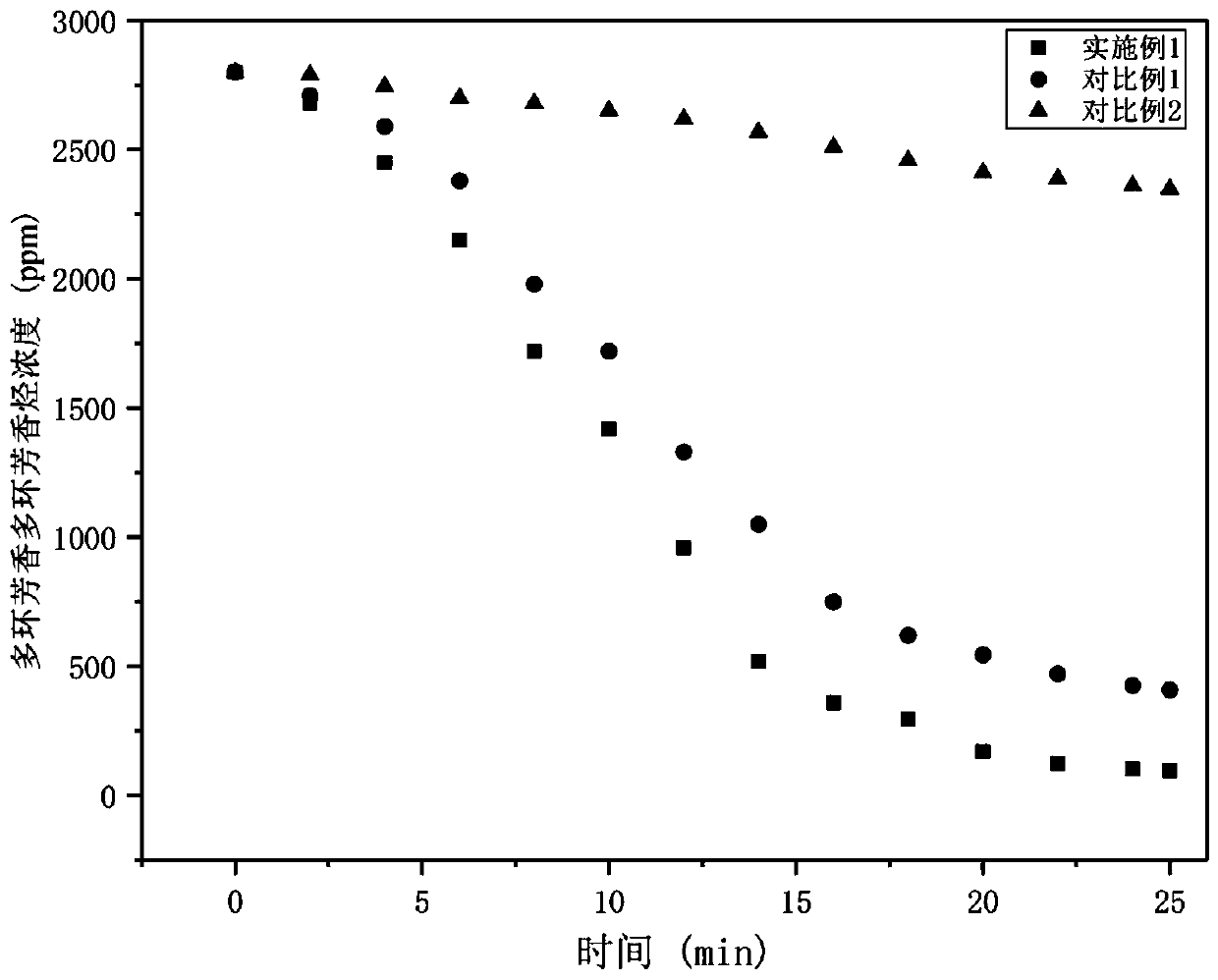Method for polycyclic aromatic hydrocarbons in wastewater through acetaldehyde intensified photodegradation
A polycyclic aromatic hydrocarbon and photodegradation technology, which is applied in chemical instruments and methods, special compound water treatment, light water/sewage treatment, etc., can solve the problem of high photocatalyst addition, easy to cause harm to people, and low photocatalytic efficiency and other problems, to achieve the effect of improving photocatalytic effect, good photosensitive activity and improving decomposition efficiency
- Summary
- Abstract
- Description
- Claims
- Application Information
AI Technical Summary
Problems solved by technology
Method used
Image
Examples
Embodiment 1
[0036] A method for acetaldehyde-enhanced photodegradation of polycyclic aromatic hydrocarbons in wastewater, said method comprising the following steps:
[0037] (1) Micro-oxidation treatment: Add 0.035% hydrogen peroxide of wastewater quality to the wastewater containing 2800ppm polycyclic aromatic hydrocarbons, and stir for 45 minutes to obtain micro-oxidation wastewater;
[0038] (2) Pretreatment solution preparation: add 800ppm of acetaldehyde to the micro-oxidation wastewater to obtain a pretreatment solution;
[0039] (3) Ultraviolet photocatalysis: Pass the pretreatment liquid into a container with a multi-layer photocatalytic plate inside, and then irradiate the container with a wavelength of 254nm and an irradiation intensity of 100uW / cm 2 UV light for 25 minutes to obtain degraded wastewater.
[0040] The preparation method of the catalytic plate is as follows:
[0041] (S.1) Preparation of rare earth-containing airgel: After stirring and mixing tetraethoxysilane,...
Embodiment 2
[0051] A method for acetaldehyde-enhanced photodegradation of polycyclic aromatic hydrocarbons in wastewater, said method comprising the following steps:
[0052] (1) Micro-oxidation treatment: Add 0.045% hydrogen peroxide of wastewater quality to the wastewater containing 1800ppm polycyclic aromatic hydrocarbons, and stir for 35 minutes to obtain micro-oxidation wastewater;
[0053] (2) Pretreatment solution preparation: add 500ppm of acetaldehyde to the micro-oxidation wastewater to obtain a pretreatment solution;
[0054] (3) Ultraviolet photocatalysis: Pass the pretreatment liquid into a container with a multi-layer photocatalytic plate inside, and then irradiate the container with a wavelength of 254nm and an irradiation intensity of 115uW / cm 2 UV light for 25 minutes to obtain degraded wastewater.
[0055] The preparation method of the catalytic plate is as follows:
[0056] (S.1) Preparation of rare earth-containing airgel: After stirring and mixing tetraethoxysilane,...
Embodiment 3
[0066] A method for acetaldehyde-enhanced photodegradation of polycyclic aromatic hydrocarbons in wastewater, said method comprising the following steps:
[0067] (1) Micro-oxidation treatment: Add 0.001% hydrogen peroxide of wastewater quality to the wastewater containing 2500ppm polycyclic aromatic hydrocarbons, and stir for 30 minutes to obtain micro-oxidation wastewater;
[0068] (2) Pretreatment solution preparation: add 300ppm of acetaldehyde to the micro-oxidation wastewater to obtain a pretreatment solution;
[0069] (3) Ultraviolet photocatalysis: Pass the pretreatment liquid into a container with a multi-layer photocatalytic plate inside, and then irradiate the container with a wavelength of 254nm and an irradiation intensity of 80~120uW / cm 2 UV light for 10 minutes to obtain degraded wastewater.
[0070] The preparation method of the catalytic plate is as follows:
[0071] (S.1) Preparation of rare earth-containing airgel: After stirring and mixing tetraethoxysila...
PUM
 Login to View More
Login to View More Abstract
Description
Claims
Application Information
 Login to View More
Login to View More - R&D
- Intellectual Property
- Life Sciences
- Materials
- Tech Scout
- Unparalleled Data Quality
- Higher Quality Content
- 60% Fewer Hallucinations
Browse by: Latest US Patents, China's latest patents, Technical Efficacy Thesaurus, Application Domain, Technology Topic, Popular Technical Reports.
© 2025 PatSnap. All rights reserved.Legal|Privacy policy|Modern Slavery Act Transparency Statement|Sitemap|About US| Contact US: help@patsnap.com

